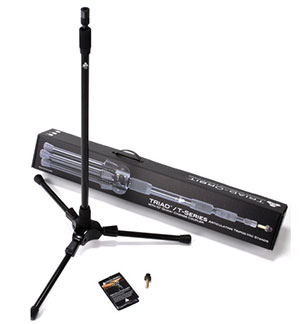 I am having one of those “I-have-got-to-get-me-one-of-these” moments right now. I just found out about a new microphone stand that solves a lot of problems I really need solving. I know, what in the way of “innovative” can be brought to the lowly mic stand? the answer is the Triad-Orbit modular mic stand system. The Triad-Orbit has interchangeable parts that allow you to – are you ready for this? – snap on/off a shock-mount or microphone in like 3 seconds! I can’t tell you how much time I’ve in my life changing microphones. Studio mics tend to have their own clips, and/or their own shock-mounts. Usually, to move my primary microphone (Rode NT2-A) from its normal position on my desk boom to a mic stand in the middle of the room, I have to remove the heavy mic from the shock-mount. Then I have to unscrew the shock-mount from the desk boom. Next, I screw the shock-mount onto the new stand. And finally, I screw the mic back into its mount. The entire operation takes 3-to-5 minutes. With the Triad-Orbit system, I could uncouple the mount with the mic in it from the desk boom and clip it onto the new stand in about 5 seconds. And that is only 1 of the cool things the Triad-Orbit system can do. Each Triad stand uses the standard 3-leg set-up, but those legs have 4 ratcheting positions. That means you can change the angle of each leg. If floor space is an issue, this allows you to shrink the stand’s footprint. And since each leg can be adjusted independently, the ratcheting ability allows you to angle the stand into unusual positions.
I am having one of those “I-have-got-to-get-me-one-of-these” moments right now. I just found out about a new microphone stand that solves a lot of problems I really need solving. I know, what in the way of “innovative” can be brought to the lowly mic stand? the answer is the Triad-Orbit modular mic stand system. The Triad-Orbit has interchangeable parts that allow you to – are you ready for this? – snap on/off a shock-mount or microphone in like 3 seconds! I can’t tell you how much time I’ve in my life changing microphones. Studio mics tend to have their own clips, and/or their own shock-mounts. Usually, to move my primary microphone (Rode NT2-A) from its normal position on my desk boom to a mic stand in the middle of the room, I have to remove the heavy mic from the shock-mount. Then I have to unscrew the shock-mount from the desk boom. Next, I screw the shock-mount onto the new stand. And finally, I screw the mic back into its mount. The entire operation takes 3-to-5 minutes. With the Triad-Orbit system, I could uncouple the mount with the mic in it from the desk boom and clip it onto the new stand in about 5 seconds. And that is only 1 of the cool things the Triad-Orbit system can do. Each Triad stand uses the standard 3-leg set-up, but those legs have 4 ratcheting positions. That means you can change the angle of each leg. If floor space is an issue, this allows you to shrink the stand’s footprint. And since each leg can be adjusted independently, the ratcheting ability allows you to angle the stand into unusual positions.
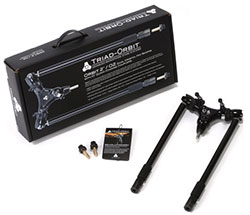
There are several other advantages to the Triad-Orbit system, including different attachments like the Dual-Arm boom, which allows you to do stereo mic set-ups with just one stand, get multiple mics into multiple positions – like drums – with just one stand, etc. And then there’s the iOrbit 1, which is an orbital iPad holder. So you can put a mic and an iPad on the same stand with the Triad-Orbit mic stand system. For more details, CLICK HERE.
The New Zoom H5 Handy Recorder Finally Available
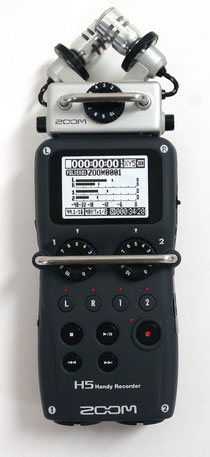 The long-awaited Zoom H5 Handy Recorder (the smaller, more affordable version of the H6) is finally here!
The long-awaited Zoom H5 Handy Recorder (the smaller, more affordable version of the H6) is finally here!
The Zoom H-series of hand-held digital recording devices are incredible – allowing you to record pro quality audio with an all-in-one unit (mics, power, preamps, conversion, storage and even some editing!) that you can hold in your hand (hence…..the term….hand-held:-P).
Anyway, the Zoom H5 Handy Recorder was recently announced, boasting all the essential features of the much more expensive H6, but smaller and more affordable. However, though the tantalizing description has been out there for a bit, you couldn’t actually get your hands on one. Now you can get your own if you CLICK HERE.
So what is the H5? Well, let’s start with one of its predecessors, the Zoom H4n. It was incredible for any number of on-the-go recording applications, and it became the “holy grail” for videographers and film-makers (especially the ones using DSLRs) because it allows you to record fantastic audio while doing location shoots, something very difficult to do. Also, you could use the H4n as an audio interface for your computer because it had two XLR (standard 3-pin) mic inputs. It was fabulous for any number of mobile recording purposes.
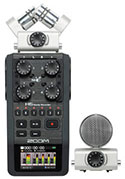
Zoom then improved on the H4n, which was already recognized as a world-class “next gen” portable audio recorder, by coming out with the H6, which is mind-blowing. It fixed all the things that were a bit bothersome about the H4n, like sometimes not providing enough gain, noisy level buttons, etc. Plus there are tons of new features with the H6 – the most amazing of which is the modular/interchangeable mic system that allows you to switch out the standard X-Y stereo mic on top with an array of other mic modules, including a shotgun, mid-side (MS), and dual XLR/TRS. They also added improved preamps, a color screen, and a number of other bells and whistles. And for all of this awesomeness, the price of the H6 ($399.99) is just about double that of the H4n.
Enter The H5
The H5 scales back on some of the features on the H6 – things like the color screen, number of inputs, etc. But the H5 retains all the essentials. For example, it has the same audio recording quality, modular mic system compatible with all the H6 Mic Modules, physical transport controls, etc. as the H6. It’s also quite a bit smaller, making it more convenient. And the best news of all? The price! The H5 is only $269.99, 130 bucks less than its big sibling. That makes it much more accessible for hobbyists (or anyone else on a tough budget), while continuing to provide professional level quality.
So now that they are in stock at B&H, CLICK HERE to get yours:).
Cheers!
Ken
Folders In Reaper Instead Of Submix Busses
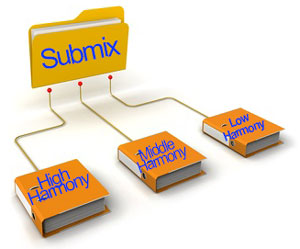 Wow! Even the title of this post started to make my brain seize up before I was even done writing it. The phrase “bored already” comes to mind.
Wow! Even the title of this post started to make my brain seize up before I was even done writing it. The phrase “bored already” comes to mind.
But I left it that way because folks who have done lots of recording before will understand what a submix bus (sometimes – even by me, depending in part on how much caffeine I’ve had – spelled “buss“) is.
If you don’t know what it is, see my article What is a Buss in Audio Recording?
OK, now I expect everyone to know what a submix bus is. You DID read your assignment didn’t you? I thought so. In most multitrack audio software programs (usually called digital audio workstations, or DAWs for short), if you want a submix (like the example of “one track to rule all the harmony tracks,” remember? From your reading?), you first have to create a special kind of track – a bus.
Then for each of the tracks whose audio you want inside the submix, you have to disable the “sends” going to the master bus. That’s because a bus track merely taps the audio on its source tracks – like creating a clone of it. It doesn’t stop those tracks from ALSO sending their audio to the master track. If your goal (as it often is with a submix) is to be able to control the volume of ALL the tracks in the submix group (like all the harmonies, say) with just a single knob/slider (the one on the submix bus track), then ALL of the audio from each of the original tracks needs to be routed through the submix track. Otherwise (I’m going back to the clone simile here), you could make the harmony clones be quiet by turning down the volume on the harmony submix track. But the originals – the “not clones” – are still yapping away, making all kinds of loud harmony-type sounds. Your submix track can’t control the originals! So you must destroy the originals (Insert dramatic music here) by disabling those “sends” headed for the master bus.
Enter The Track Folders
In Reaper – my favorite DAW – they have something called track Folders. They make it soooooo (is that enough “Os”?) easy to create a submix. Here is how you do it. Don’t look away because you might miss it (it’s THAT quick and easy)!
- Insert a new track (no need to worry about what KIND of track or anything) above your harmony tracks.
- Click on the little folder icon on the right side of the new track’s control panel.
- Click the folder icon of the last harmony track twice. Done!
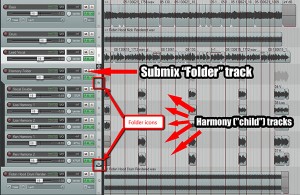
It took longer to type that than to actually do it. Assuming you have the correct mix (relative volumes) of the harmony parts against each other, all you have to do to control EVERY harmony in the folder track – put on reverb, turn them up or down in volume, compress them, etc. – is do it to that top track.
As I mentioned above, the tracks that get put into a folder are shown as indented (see the picture on the right), and are considered “child” tracks in the folder. The folder track at the top is the controlling or “parent” track for the submix created by the folder.
Using folders in Reaper is a HUGE time saver, and the best way to create a submix that I know of.
By the way, you can still do everything in Reaper “old school,” like creating “sends” from each harmony track and directing them to a new track that you call a “bus,” etc. if you want to. Maybe you have some special need for doing things the hard way, or maybe you want to teach someone how it used to be done in the old days. Some folks may want to do it this way for a very specific and unusual effect or something. But as far as I’m concerned, folders are the way to go!
Getting The Vocal To Blend Well In The Mix
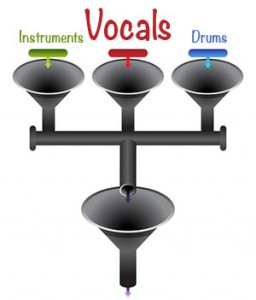 A friend sent me a private message on Facebook asking me about a recording problem he was having. He had recorded the music for a song, and that sounded great. Then he went ahead and recorded the vocal track, and that, by itself, sounded pretty decent too. However, he reported that the vocal was too up front in the mix. It didn’t blend in with the music, so they didn’t sound like a cohesive performance. He asked me if I had any ideas for getting the vocal to blend in better with the music. It turns out that I do:-P. Below is the advice I gave him:
A friend sent me a private message on Facebook asking me about a recording problem he was having. He had recorded the music for a song, and that sounded great. Then he went ahead and recorded the vocal track, and that, by itself, sounded pretty decent too. However, he reported that the vocal was too up front in the mix. It didn’t blend in with the music, so they didn’t sound like a cohesive performance. He asked me if I had any ideas for getting the vocal to blend in better with the music. It turns out that I do:-P. Below is the advice I gave him:
My Reply
Hi Ric! Yes, I do have a couple of ideas for you to try. The standard answer is to add reverb. You don’t have to add much to make it seem a bit further back in the mix. In fact sometimes you can get the “pushing further back” effect with so little reverb that you can’t really hear the verb in the mix. If you solo the vocal, you can hear it, but when all tracks are playing, the effect is simply to make the vocal seem a bit further away.
However, as with anything, the best way is a bit more involved, doing several things, but doing them in small doses, so that it’s the combination of several small things that create one subtle but significant effect (I’m always amazed at how similar cooking is to mixing). So here are some things to add to the act of applying just a pinch of reverb.
- Obviously, you can just turn the volume down on the vocal track. But then you might have trouble hearing the softest words/phrases.
- In that case, add a compression effect to the vocal track to even out the dynamics.
- Also, “ducking” is an awesome way to get the vocal to sink more into the mix. Here is an article I wrote about ducking: https://www.homebrewaudio.com/what-is-ducking-in-audio-recording/
- Then to fine-tune things, I recommend listening to the mix in the car and on an iPod/iPhone through headphones. Check for notes that pop out a little too loud or that are maybe too soft to hear, and make notes. Printing a lyric sheet and taking that with you to make these notes is highly recommended (yeah, I do this a lot:)). When you have all the notes, go back to your software and put a volume envelope on the vocal track. you can use that to quickly raise or lower just certain syllables or short words.
If you do just a smidgen of ALL of those things, you’ll probably be quite happy with the result.
Good luck!
Filters For Fun And Profit: What Do IIR And FIR Mean?
One of the most useful tools at your disposal when recording any kind of audio – music or voiceover – is good noise reduction. I wrote a post about the hidden noise reduction tool in Reaper that is actually just one function of a filter that comes free (along with dozens of other effects) with Reaper (www.reaper.fm), called ReaFIR. That post, along with the associated video, is: ReaFIR Madness – The Hidden Noise Reduction Tool in Reaper.
I made some wise crack about FIR standing for something technical and inscrutable. But in fact, Finite Impulse Response (FIR) is a type of digital audio filter with several uses to help you fix, enhance, or otherwise alter your audio. Here is an article that, along with its predecessor (the article, not the filter) about infinite response filters (IIR):
http://music.tutsplus.com/tutorials/filters-and-you-fir-filters–audio-23400